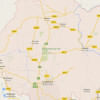Is every step a risk? Addressing Dhaka’s road safety crisis

"I lost my father to a road accident. So, you see, I know the fear and gravity all too well. Recently while in Bashundhara, the CNG I was in collided head-on with another. I got scared to death."
"The anxiety associated with crossing the road is not something new. But for people like me, who have pre-existing trauma, the daily news of road accidents only aggravates the situation," shares Faiaz, a business executive, who carries the weight of grief and fear with him each day.
In Dhaka, the symphony of traffic never ceases — rickshaws, buses, and crowds push forward in a relentless tide of movement. Amid this everyday hustle, the city's roads present a dangerous paradox: they are both lifelines and lethal threats.
For many of Dhaka's residents, simply crossing the street has become an ordeal fraught with danger and anxiety, especially for those like Faiaz, who have suffered personal losses to road tragedies.
Just think of the tragedy that recently happened in Badda, where the lives of two sisters got destroyed due to the competition of two local buses — with one being severely injured and another losing her life.
Farhana, a schoolteacher, whose daily commute similarly includes navigating one of Dhaka's busiest intersections. Each day, she clutches her bag close and takes a deep breath before stepping off the curb.
"It's like steeling yourself for battle," she confides. "Several times, I have seen bikers or cyclists hitting pedestrians and just drive away. Now, crossing the street feels like an act of survival."
The root causes of this chaos are manifold. Overpopulation and under-regulation breed a culture of reckless driving. Traffic laws, though well-documented, are often flouted openly, with little to no consequence. Buses race to pick up passengers, motorcyclists weave through gaps with inches to spare, and rickshaw pullers push through the metal and fumes with determined resilience.
Reema, a homemaker and mother of two, echoes the sentiment of dread. "Crossing the road in Dhaka, there's no guarantee you'll return home safely," she says, highlighting the reckless competition among local buses that ignore traffic signals completely. "At certain crossing points, there aren't even foot-over bridges. You have to cross with other pedestrians just to go from point A to B."
"Many people get run over, but do the perpetrators get punished? In reality, nothing happens! Nowadays, it is very easy to kill someone and get away with it."
The crux of the issue lies in the inadequate enforcement of traffic laws, and the absence of strict penalties for violators. This systemic failure not only encourages reckless driving, but also ensures that perpetrators remain unpunished, perpetuating a cycle of danger and fear.
The dire state of pedestrian safety is compounded by inadequate lighting and security on essential structures like foot-over bridges, as described by Nisa, a master's student. "The foot-over bridge I use is unlit and unsafe at night, frequented by miscreants," she explains. "I'm forced to choose between potential harassment and the risk of crossing busy roads on foot."
Similarly, Iffat, a software engineer, illustrates the unpredictability and lawlessness that pedestrians face daily. "Even looking both ways aren't enough anymore," he says, frustrated. "Drivers treat one-way streets as two-ways and act like they own the road. It's chaos."
Each of these voices paints a stark picture of life in Dhaka, where the streets are fraught with danger. The narrative isn't merely about inconvenience. It's about a pervasive threat to life and a palpable fear that touches everyone — from the young student to the elderly commuter.
Addressing this crisis requires urgent and comprehensive measures. Stricter enforcement of traffic laws is essential, but so is a cultural shift towards greater road safety awareness. Educating drivers and pedestrians, improving infrastructure like pedestrian crossings and street lighting, and ensuring accountability for traffic violations can all contribute to safer streets.
The vision of transforming Dhaka's roads from zones of fear to conduits of safe passage is ambitious but achievable. It requires the concerted effort of the entire community — from policymakers to pedestrians.

 For all latest news, follow The Daily Star's Google News channel.
For all latest news, follow The Daily Star's Google News channel. 










Comments